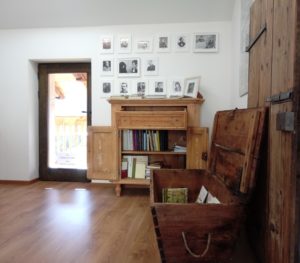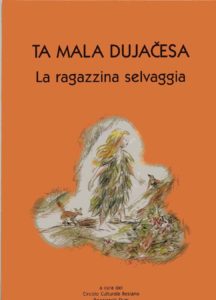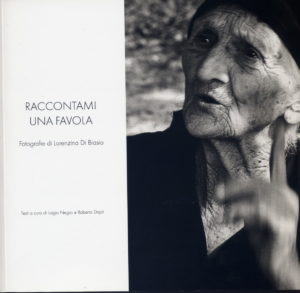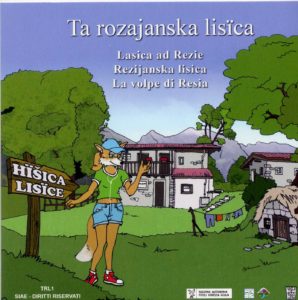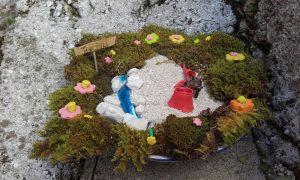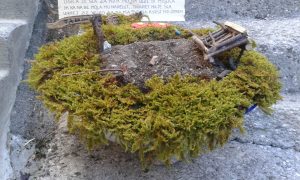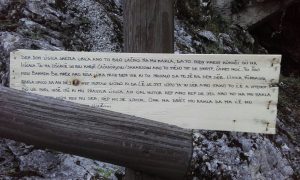THE SECTION DEDICATED TO THE ORAL HERITAGE
Introduction
Among the most characteristic aspects of the Resia Valley, next to the traditional music, dance and craft of the knife grinder, we can place the rich oral heritage that consists of the fables and tales.
Thanks to a specific financial contribution of the Friuli Venezia Giulia Region, assigned in 2014 to our museum, it was possible to establish in our new museum a temporary exhibition dedicated to this important aspect. This exhibition took place from October 2017 to March 2020.
Of this exhibition we have now a special section with an archive that can be continuously implemented. Here you can discover the resian fairy-tales, the storytellers, specially Tina Wajtawa, the scholars, espetially Milko Matičetov, and books.
The folk-tales
To this day the Resia Valley preserved an interesting oral tradition, which consists of fables, tales, legends, folk songs and other documents.
There are fables of kings, princes and princesses and stories about the Dujak, the wild being, Dujačesa, his wife, and Dujačesica, their daughter. They inhabit our forests and express themselves in their own language, unknown to us. Among the protagonists of fairy tales there are also wild beings like the Gardinica, whose name derives from the adjective „gard“ (ugly).
Other legendary beings are Dardej and Lol kutleć. Dardej is still mentioned for helping the villagers of Stolvizza not to lose the pastures of Sart, whereas Lol Kutleć is remembered for his strength.
In Stolvizza we know the story of Kodkodeka, who burned his own house and the entire village. Another typical story of Stolvizza is the one about the prince of the castle.
The main protagonists of fairy tales are the fox / lisica and the wolf / uk. But there are other stories starring other animals, such as the hare / zec, the rooster / pitilen, the dog / pas, the cat / tuca, the bear / midved and many others.
Among popular songs we should mention Sveti Sinti Lawdić and Linčica Turkinčica. The first tells the story of King David, who went on finding his father, mother and brothers in hell and of their salvation thanks to his intervention. The second is starring kralj Matjaž, ungarski kraj or Mattia, the King of Hungary, who escaped from a Turkish prison with the help of Linčica Turkinčica, daughter of the Turkish sultan, who followed him in his kingdom, and there married his third son.
Noteworthy is the presence in the valley of songs starring Lepa Vida, also known as Lipa Lina or Lipa Wida, who similarly to kralj Matjaž is a central character of the Slovenian literature.
Even today are well known in the valley the narrative songs with religious themes such Tičica Arličica and Sveti sint’Antunišeć.
Other stories tell of the occult, the afterlife, the lives of the saints and the stories of Jesus and St. Peter.
Among the oral testimonies we should mention nursery rhymes, riddles, sayings and stories about real life.
The divisions of folk-tales
When we come to the consideration of folk-tales we find that they can be broadly divided into two categories, Folk Narratives or Folk Fiction, and Folk Legends or “Sagen”.
Folk narratives. There are many categories into which Folk Narratives can be divided. That used in the Aarne-Thompson Types of the Folktale is pretty generally followed. The general headlings are: I Animal Tales, II Ordinary Folk-Tales. Then III Jokes and Anecdotes, IV Formula Tales, and there is one short section of Unidentified Tales. All except this last are sub-divided, generally to differentiate between the people of whom the stories are told.
Legends. The legends have no such over-all coverage as the Narratives, but are often dealt with on a more national basis.
This is understandable because of the particularity of the Legend, believed to have happened at a definite time and place.
(Katherine Briggs, British Folk-Tales and Legends, 2002)
The female and male storytellers
In the past the tradition of storytelling was very widespread also in our valley: in the evening, when the people returned home after a hard day at work, the kids, but not only, were entertained by the storytellers.
Each village had excellent female and male storytellers, who could convey with great oratorical ability the many fables and stories they knew.
In Solbica / Stolvizza the most renowned storyteller was definitely Tina Wajtawa / Valentina Pielich, (1900 – 1984).
Each storyteller had its own way of telling that fascinated the audience.
Many storytellers told their stories also to researchers.
The art of storytelling
Very important in the transmission of the oral heritage is also the way in which it is transmitted. Many storytellers, in fact, distinguished themselves for their great narrative ability.
Today – even if the ways of narration have changed in respect to the past, since today stories are often read to children – there are new forms with which modern storytellers express themselves.
There are different festivals around the world dedicated to this art. Since 1998 a storytelling festival is being held in Slovenia which was also attended by the Resian storytellers, who told tales also in Resian.
At international level there is the Word Storytelling Day. Each edition has its own specific theme.
It is possible in the museum to hear tales of the local oral tradition from the voices of cultural operators Sandro Quaglia in Luigia Negro.
Short biography of Sandro Quaglia
Short biography of Luigia Negro
The books
Listening to stories and fables has been and is still part of our daily lives. Once it was the grandmother who told the stories, while today they are handed down in the form of books and other modern means.
The Cultural Association „Rozajanski Dum“ published, in 1998, the book Ta prawä pravicä od lisïcä od Rezia / La vera storia della volpe di Resia and, in 2004, the books Ta mala Dujačesa / La ragazzina selvaggia and Raccontami una favola with texts from the local oral heritage. The latter book is complemented by photographic images portraying valley elders, photographed by Lorenzina Di Blasio Nadalawa.
In the ‘70s of the 20th century the book Zverinice iz Rezije was transformed in the eponymous series of animated puppets, broadcasted on the Slovenian national TV. Today the same series is available on DVD.
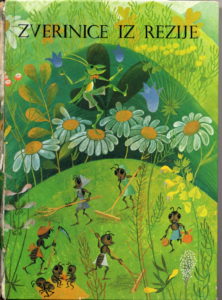
In 2011 the Mountain Community of Gemona, Canal del Ferro and Val Canale published the DVD Ta rozajanska lisica / Lasica ad Rezie / Rezijanska lisica / La volpe di Resia with the animatix technique.
Audio video
These stories are also aired on the weekly radio broadcast Te rozajanski glas, which has been transmitted, for over fourty years, by RAI Slovenian regional headquarters in Trieste.
Events
In the ‘90s of the 20th century, the Cultural Association „Rozajanski Dum“ for ten years organized, with the intent to promote the art of storytelling, the Tales’ week with themed events in the various villages of the valley.
Finally, since 2012, in Stolvizza / Solbica every year we organize itineraries with texts and illustrations drawn from the local narrative tradition.
In 2017 we create with the children of our village some mini fairy tale gardens with the story of the fox and the wolf
Researchers and scholars of the oral heritage
Already at the end of the 18th century, the Resia Valley was visited by the Polish nobleman and writer Jan Potocki. His descriptions of the local places and people have been published by Jan Dobrowsky and Jernej Kopitar. In 1841, the folklore and linguistic heritage of the Resia Valley was collected also by Stanko Vraz and the linguist Ismail Ivanovič Sreznjevskij.
In 1873 the valley was visited for the first time by the Polish linguist Jan Baudouin de Courtenay (1845 – 1929), who visited the valley on several other occasions. In 1876 he published the book Rez’ja i Rez’jani. These were the first published stories of the oral tradition of the Resia Valley. The scholar was interested above all to the linguistic, cultural and social aspects of the valley. By basing his work on his extensive researches, he published texts of great scientific value, including the volume Materiali dlja južnoslovjanskoj dialektologii i etnografii I (Sankt Petersburg 1895), in which the stories are written in the various Resian variants with a German translation. The protagonists of the stories are the fox and the wolf, kings, princes and saints.
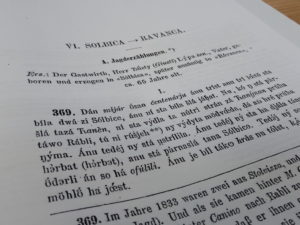
For his significant research work, in particular of folk songs and tales, we should undoubtedly mention also Prof. Pavle Merku from Trieste.
The scholar, who was most interested in the oral heritage of the Resia Valley was the Slovenian academic Milko Matičetov (1919 – 2014), one of the leading European experts in oral tradition. Since the ‘50 of the 20th century, he collected, recorded and catalogued hundreds of fables, fairy tales, legends and mythological tales on behalf of the Slovenian Academy of Sciences and Arts of Ljubljana. He began collecting the materials in 1962, and later constantly visited the valley. He published numerous studies and attended several International conferences, introducing the culture of this valley to the international scientific audience. Among his best-known publications concerning the Resia Valley we should mention the collection of popular poems Rožice iz Rezije, published in 1972, and the book Zverinice iz Rezije, published in 1973, which collects sixty tales starring wild animals. Later he published several other books, including Tri lisičice gotrice. Before his death the volume Fiabe resiane / Rezijanske pravljice / Pravice po rozajanskin was published. The volume comes with a CD with six Resian fables recorded by Milko Matičetov and one recorded by Roberto Dapit.
The oral tradition of the valley has been covered for several years by the Friulian linguist Roberto Dapit, professor at the University of Udine, which continues the research work on the field, publishes studies and collaborates in the preparation of scientific publications. Among his works we should mention Aspetti di cultura resiana nei nomi di luogo 3. Bila / San Giorgio, Njiwa / Gniva anu Ravanca / Prato, which contains several texts from the local oral tradition.
Under his guidance, in 2007, the graduate student Cristina Lorenzi discussed at the University of Udine the first dissertation on the oral heritage of the Resia Valley.
The scholar Milena Mileva Blazić has been working on Resian fairy tales and storyteller Tina Wajtava for several years.
Researches, studies and classification of folk-tales
Brothers Jacob Ludwig Karl (1785 – 1863) and Wilhelm Karl Grimm (1786 – 1859) have, both with their work and the collection of fables Kinder-und Hausmarchen (1812, 1815), made a big leap in the history of collecting and researching fables, but important collections of fables were created long before them.
World famous are Gianfrancesco Straparola (Le piacevoli notti 1550-53), Giambattista Basile (Pentamerone 1637), Charles Perrault (Les Contes de ma mere l’Oie 1697) and Madame d’Aulnoy (Contes Nouveaux ou Les Fees a la Mode 1698).
The research and dissemination of fables in writing and the collection of folk tradition has evolved expecially in the 19th century.
The first scientific classification of fables was attempted by the Finnish scholar Antti Amatus Aarne (1867 – 1925), who in 1910 published the volume Verzeichnis der Marchentypen („The fairy tale types“).
This initial classification was extended by the American scholar Stith Thompson (1885 – 1975), author of the Motif-Index and The Types of Folktale.
Later, the German scholar Hans-Jorg Uther (1944) furtherly enriched this system and proposed to call it Aarne-Thompson-Uther (ATU).
In Italy, the first scientific publication with the classification of the oral heritage dates back to 1975. The title of the book is Tradizioni orali non cantate – Primo inventario nazionale per tipi, motivi o argomenti.
The Resian fables’ classification has been published in the volume Tipni indeks slovenskih ljudskih pravljic, written by Monika Kropej Telban (2015).
The researchers of the oral tradition have in the International Society for Folk Narrative Research, founded in 1962 in Belgium, their international reference.

